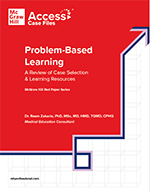How to Implement Problem-Based Learning in a Traditional Curriculum
How to Implement Problem-Based Learning in a Traditional Curriculum
It’s well established that a problem-based learning strategy (PBL) helps medical students with longer term learning and the application of knowledge to real-life situations. Yet integrating it into an existing traditional course can be tricky. Here, we’ll look at some of the ways that medical faculty members can implement problem-based learning in the classroom.
What is problem-based learning?
Traditional medicine, nursing and other healthcare courses require students to learn a great deal of information in the early years. Yet often, when it comes to later exams, students find they have forgotten much of this knowledge. Plus, they may struggle to apply their learning in real-world clinical situations.
Problem-based learning seeks to bridge these gaps by starting with the application of knowledge and using this to stimulate further research. Small groups of students are given an interdisciplinary and integrated case to analyse together, prompting them to identify gaps in their knowledge. They then go away to carry out self-directed learning, before returning to their group to share their new knowledge.
How to implement problem-based learning in the classroom?
Faculty members’ role in problem-based learning includes formulating suitable case scenarios, facilitating group discussions, guiding students in further research, and arranging visits by experts and/or people/ patients affected by the condition under investigation.
Providing students with the right resources and support takes huge skill. This pedagogy seeks to develop students’ problem-solving, self-directed learning, collaboration, and communication abilities – all of which will be undermined if teachers are too directive or restrictive.
Integrating and implementing problem-based learning in the classroom
One major complaint levelled against problem-based learning is that it can be too time consuming for both students and educators. Students may fail to cover all the subjects required to become a practising clinician, while faculty members may struggle to prepare resources and facilitate group sessions.
Therefore, a hybrid approach is most commonly used in medical schools.
What can a hybrid approach mean in practice?
- PBL in early or later years: There are concerns that young medical students straight out of high school are not used to PBL methods and may need to acquire some basic preclinical knowledge first. Conversely, PBL methods in the early years of study can aid with deeper learning and engage students in subjects that might otherwise seem dry. In later years, PBL is a motivating way for students to put their learning and prior knowledge into practice. In both cases, a hybrid approach is beneficial.
- Single modules vs mainstreaming: A hybrid PBL approach can mean teaching some modules traditionally through lectures, tutorials, lab work etc, and using pure PBL pedagogy for separate modules. It can also mean teaching all or most modules through a mixture of traditional and PBL methods. Both are used by medical schools today.
- Lectures complementing PBL: Lectures can be used to impart complex or wide-ranging knowledge that a single PBL case study cannot cover. For example, lectures might cover all topics and concepts in anatomy, while a PBL case study would look in-depth at just one or two topics.
- Tutorials/ seminars complementing PBL: The traditional tutorial format lends itself well to PBL, with tutors facilitating students’ learning rather than instructing them. Some skeptics say that PBL wastes tutors’ expertise; however, it may be possible to offer some student-centered and some teacher-centered tutorials to get the best of both worlds.
- Lab work and simulations: These can be tailored to the topics covered in the PBL session, so the two approaches complement each other.
- Interdisciplinary vs compartmentalized approach: By combining the PBL interdisciplinary approach with traditional teaching in specific topics, faculties give their students a rounded education, capitalizing on the benefits of both methods. The compartmentalized approach focuses on students grasping the fundamental concepts and theories, taking on the more traditional teaching approach. Whilst the Interdisciplinary approach encourages students to apply these methodologies to real-world situations.
- Assessment: PBL is often assessed through methods such as self and peer assessment, learning reflections, and project narratives. These can supplement traditional exams to give a fuller picture of each student’s potential.
Problem-based learning is rewarding yet challenging for students and faculties alike. McGraw Hill’s new guide, Problem Based Learning: A Review of Case Selection & Learning Resources, aids educators in the process. Download it for free today.




